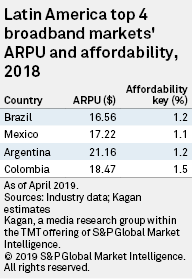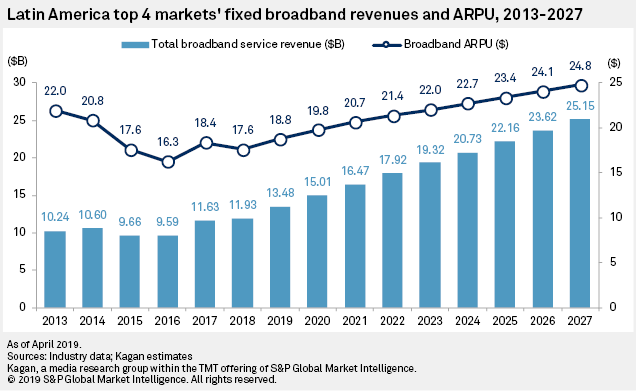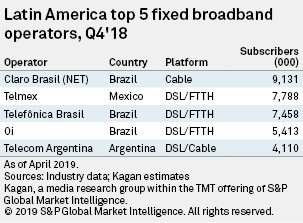In 2018, residential fixed broadband revenues in Latin America's four largest broadband markets grew an estimated 2.5%, reaching $11.93 billion. According to Kagan estimates, Brazil, Mexico, Argentina and Colombia totaled 58.2 million subscribers, representing 77.8% of the region's total fixed broadband households. We project the broadband market for the aforementioned countries will reach 85.8 million subscribers by 2027, generating $25.2 billion in revenues.

Over the past five years, broadband revenues in the four countries have jumped 16.5% while subscribers grew 41.9% as increasing competition, expanding footprints and cheaper technologies helped the service become more affordable for residential consumers in the region. In 2018, broadband prices in the four markets are estimated to have dropped 4.4% to an average of $17.60. Increasing adoption of higher speeds, however, is expected to help drive broadband average revenue per user growth in the next 10 years, as high-speed services become available with the expansion of fiber to the home, or FTTH, and DOCSIS 3.x upgrades occur among cable providers.


Kagan estimates residential broadband ARPUs in the four markets will grow to $24.82 by 2027, doubling revenues to $25.15 billion. We project the total Latin American broadband market will reach 112.4 million households by 2027 and that Brazil, Mexico, Argentina and Colombia will continue to represent more than 75% of subscriptions.
During 2018, cable overtook DSL as the largest fixed-broadband platform in Latin America, and this trend is also reflected in the region's four largest markets. At year-end 2018, Kagan estimates that DSL subscriptions in Argentina, Brazil, Colombia and Mexico fell 3.5 percentage points to 39.4% of total broadband households, while cable grew 1.3 percentage points to represent a 41.6% share. Fiber households grew 2.2 percentage points to 13.7% of total broadband subscribers.

In Brazil and Mexico, telcos such as Telefônica Brasil and Telmex rush to migrate legacy DSL users to FTTH in order to mitigate subscriber losses to cable operators' high-speed offers and multiplay bundles, which have driven cable broadband growth over the past few years. According to Mexican regulator IFT, Telmex's fiber subscriber base grew 16.9% year over year in the third quarter of 2018, while in Brazil, Telefônica reported 45.4% FTTH growth in the same period.

Already a client? Click here to access the full article, including for Latin America top four fixed broadband markets projections through 2027 in Excel format. For individual country data, click the links below to access the full country report. To view subscriber data for these and other operators over a specified time period, please refer to the Global Multichannel Top Operator feature report linked here.
Latin America broadband highlights
Brazil broadband outlook: Brazil has seen broadband average revenue per users grow in local currency driven by subscriber migration from low-speed DSL connections to high-speed fiber services. In 2017, the Brazilian market saw DSL households drop for the first time as the country's largest DSL operator Telefônica shed a total of 361,298 subscribers. Kagan estimates that Brazilian broadband households continued growing rapidly in 2018, becoming the world's sixth-largest fixed broadband market at 27.6 million subscribers, 39.2% household penetration and revenues estimated at $5.3 billion.
A reduced version of this article is available on our public blog here.
Mexico broadband outlook: Telmex dominates Mexico's residential broadband market, holding 51.6% of broadband households and 63.8% of revenues as of end-2017. Residential broadband affordability for Mexican households has improved, however, due to the increasing penetration of less expensive cable broadband, led by Grupo Televisa's cable operators. Kagan estimates Mexico ended 2018 as the world's 11th-largest fixed broadband market with 16.0 million subscribers, or 46.8% household penetration, and $3.2 billion in revenues.
Argentina broadband outlook: Argentina's fixed-broadband market was the market most affected by the merger of cable operator Cablevisión Argentina and telco Telecom Argentina, effective Jan. 1, 2018, since the broadband service was the only one both companies could offer under previous regulations. As the two largest internet service providers in Argentina, the two operators combined controlled 52.0% of the country's 7.8 million broadband households in 2017. Kagan estimates the total fixed broadband market in Argentina reached 8.3 million households by end-2018, or 61.4% penetration, and generated $2.1 billion in revenues.
Colombia broadband outlook: The Colombian fixed-broadband subscriber base grew steadily over the past 10 years, reaching 6.3 million subscribers and generating $1.34 billion in revenues by year-end 2018. Kagan projects the subscriber base will double by 2028. Fixed-broadband subscribers are slowly adopting faster speed plans, with most Colombians enjoying speeds between 2 Mbps and 9.99 Mbps. Claro Colombia was the market leader with a 37% share by year-end 2018. Telefónica Colombia and ETB are leading the way in fiber to the premises, or FTTP, and we forecast there will be 3.3 million FTTP fixed-broadband households by 2028. In the short-term, underserved departments of Colombia could generate $192.0 million in additional revenues.
Dominican Republic broadband outlook: Despite having the largest population among the Kagan-covered markets in the Caribbean, the Dominican Republic has the second-lowest broadband penetration rate, after Jamaica. This is attributable to the high cost of broadband and lack of infrastructure. Kagan estimates that at the end of 2018, the Dominican Republic reached 748,533 broadband households, or a 24.5% penetration rate, generating revenue of $210.3 million and an ARPU of $24.08 per month.
Latin America top 10 groups broadband outlook: Broadband revenues for the region's 10 largest telecom groups that provide pay TV reached $15.43 billion at year-end 2017. The average ARPU for the surveyed operators stood at $24.95 in 2017. Operators with a greater focus on residential services registered lower fixed-broadband ARPU: Mexican MSOs Megacable and Televisa offer competitive prices and discounts for bundled services, while Oi's high penetration of low-income residential users reduces its ARPU. América Móvil is the market leader with 32% of the region's fixed-broadband households, owning the region's two largest ISPs, Claro Brasil and Telmex. Telefónica leveraged its large fixed telephony network to position itself as Latin America's second-largest fixed-broadband provider using mainly xDSL technologies.
This article is part of Kagan's Latin America Multichannel & Broadband report. A summary of the report is available on our public blog here.
Latin America broadband speeds: Increasing availability of triple-digit advertised speeds, elimination of lower speed packages, free broadband speed upgrades and migration from copper to fiber are paving the way to faster broadband speeds in five major Latin American markets — Argentina, Brazil, Chile, Colombia and Mexico. In 2017, broadband households with 10-100 Mbps speeds dominated, with 59.6%, or 34.1 million, of a total 57.3 million subscribers. This tier is followed by households with speeds below 10 Mbps, with a 37.9% share, while speeds above 100 Mbps remain a niche offering with only 2.5% of broadband households among the five chosen markets.
Global Multichannel is a service of Kagan, a group within S&P Global Market Intelligence's TMT offering.
This article was published by S&P Global Market Intelligence and not by S&P Global Ratings, which is a separately managed division of S&P Global.



